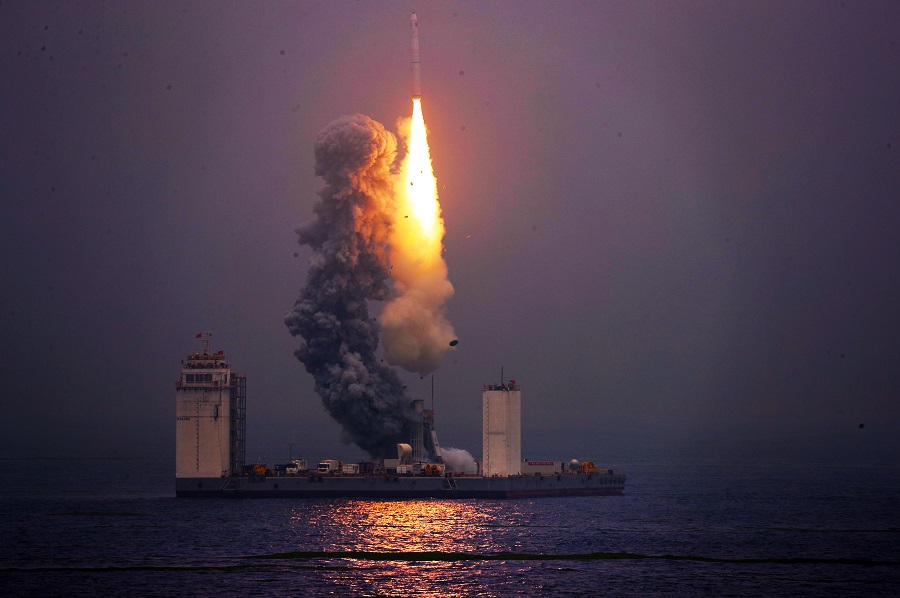Year in review: China's major scientific and infrastructure achievements
2019 marks another year of accomplishments for China. As the year comes to an end, let's take a moment to recall the many achievements China unlocked in this year that made us proud of our nation.
Editor's note: 2019 marks another year of accomplishments for China. As the year comes to an end, let's take a moment to recall the many achievements China unlocked in this year that made us proud of our nation.

Photo taken by the rover Yutu 2 on Jan. 11, 2019, shows the lander of the Chang'e 4 probe. [Photo/Xinhua/China National Space Administration]
Chang'e 4 makes world-first landing on moon's far side
The Chang'e 4 lunar probe landed at 10:26 am on Jan. 3 on the Von Karman crater in the South Pole-Aitken basin, making the first-ever landing on the far side of the moon.
China's lunar rover Yutu 2 has driven 345.059 meters on the far side of the moon, a new record of the furthest distance ever made by a rover, the Lunar Exploration and Space Program Center of the China National Space Administration said on Dec. 4.
The rover is expected to continue to break its own record as its journey on the moon goes on.

A prototype magnetic levitation train with a top speed of 600 km/h is unveiled in Qingdao, Shandong province, on May 23, 2019. [Photo/Xinhua]
Maglev train prototype with top speed of 600 km/h unveiled
China unveiled a prototype magnetic levitation train with a designed maximum speed of 600 kilometers per hour in Qingdao, Shandong province, on May 23.
The debut of the prototype marks a major breakthrough by China in the high-speed maglev trains.
The engineering prototype is expected to roll off the production line next year and to undergo comprehensive testing and be made ready for commercial manufacturing in 2021.

A Long March 11 solid-propellant carrier rocket, with a payload of seven satellites, blasts off from a mobile launch platform off Shandong province on June 5, 2019. [Photo/China Daily]
First rocket launch at sea a success
China carried out its first seaborne space launch in its territorial waters in the Yellow Sea on June 5, opening a new chapter in its space industry.
A Long March 11 solid-propellant carrier rocket blasted off at 12:06 pm from a mobile launch platform — a modified submersible craft — off Shandong province, sending seven satellites into an orbit nearly 600 kilometers above Earth.
The mission — the world's first seaborne space launch in the past five years — showed China's possession of technologies and capabilities required for such an operation and also indicated the country has found an alternative to its ground-based launch centers.

Photo taken on Nov. 5, 2018, shows a full-size model of the core module of China's space station Tianhe exhibited at the 12th China International Aviation and Aerospace Exhibition in Zhuhai, South China's Guangdong province. [Photo/Xinhua]
First batch of cooperation projects aboard China space station released
China's space station is set to welcome aboard nine international scientific projects from 17 countries covering a wide range of research areas.
They include space life sciences and biotechnology, microgravity physics and astronomy, the China Manned Space Agency and the United Nations Office for Outer Space Affairs announced on June 12 in Vienna, Austria.
China's space station is expected to be completed in 2022. The station will serve as a space laboratory to carry out multidisciplinary scientific research, technological verifications and applications.

Photo taken on Aug. 27, 2019, shows China's Five-hundred-meter Aperture Spherical Radio Telescope in Southwest China's Guizhou province. [Photo/Xinhua]
FAST telescope picks up 'mysterious radio burst' for first time
China's Five-hundred-meter Aperture Spherical Radio Telescope (FAST) has detected a repeating fast radio burst (FRB) — mysterious radio signals from outer space — for the first time. The FRB originated some three billion light years away from Earth, scientists on the FAST project revealed the news on Sept 4.
FRB is one of the hottest topics in astronomy. It was not until 2007 when the first FRB was discovered by humans. Fewer than 100 FRBs have been detected internationally to date.

Beijing Daxing International Airport's first flight, a China Southern Airlines' A380, takes off as the airport opens to traffic on Sept. 25, 2019. [Photo/China Daily]
Beijing Daxing International Airport begins operations
Beijing Daxing International Airport saw off its first flight after a China Southern Airlines' A380 left the airport at 4:22 pm on Sept. 25, headed to Guangzhou Baiyun International Airport.
The flight signaled the beginning of operations at the facility after five years of construction.
With four runways, 268 parking bays and a vast terminal building covering 700,000 square meters, the new airport is expected to handle 45 million passenger trips a year by 2022 and 72 million by 2025, with international flights accounting for 20 percent and 40 percent of the total respectively.

China's first domestically made polar icebreaker Xuelong 2 sails in the Southern Ocean on Nov. 19, 2019. [Photo/Xinhua]
Xuelong 2 starts maiden Antarctic mission
China's first domestically built research icebreaker Xuelong 2 embarked on its maiden voyage to the Antarctic from Shenzhen in Guangdong province on Oct. 15.
The voyage is a major part of China's 36th Antarctic expedition, which involves 413 scientists, researchers and support staff. Xuelong 2's predecessor Xuelong also joined the expedition, the first time that two polar icebreakers have worked together on a Chinese Antarctic expedition.
Xuelong 2 will return to China in late March while Xuelong will come back in mid-April.

Consumers experience 5G-powered virtual reality video services at a China Telecom outlet in Beijing. [Photo/Xinhua]
China enters commercial 5G era
China officially kicked off commercialization of 5G services on Oct. 31, with the nation's big three telecom operators rolling out their 5G data plans.
The move means consumers can now pay to access superfast 5G speeds as more than 86,000 5G base stations have already entered service in China, covering 50 cities nationwide.
China is set to become the world's largest 5G market by 2025, with 460 million 5G users, according to a forecast by the Global System for Mobile Communications Association, a global telecom association.

This photo shows the artistic rendering of the black hole LB-1. [Photo provided to chinadaily.com]
China-led team discovers biggest stellar black hole
An international team of scientists led by China has discovered a king-size, stellar-mass black hole in Earth's "cosmic backyard" containing the mass of 70 suns. It is the biggest known of its kind and roughly three times bigger than what scientists previously thought was possible, researchers said on Nov. 28.
The black hole, named LB-1, was found slowly devouring gas from a nearby star more than 13,800 light-years from Earth, relatively nearby, considering the estimated 105,700 light-year diameter of Earth's galaxy.
LB-1 was first spotted by Chinese scientists in 2016 using spectrum data collected by the Large Sky Area Multi-Object Fiber Spectroscopic Telescope. An international team of 55 scientists from 28 research institutions in seven nations, including China, the United States and Spain, have worked together in the past three years to confirm the discovery.

A model of BeiDou Navigation Satellite System is on display at the 20th China Beijing International Hi-Tech Expo on June 9, 2017. [Photo/Xinhua]
Core of Beidou navigation satellite network in place
With the last two medium earth orbit satellites of the Beidou's third-generation system launched on Dec 16, China has finished the deployment of the core constellation of its BeiDou Navigation Satellite System.
Currently, there are 46 Beidou satellites in service in space. The China Satellite Navigation Office intends to position two more Beidou satellites in geostationary orbit in the first half of 2020 to finish the deployment of all of Beidou's space-based assets.
Beidou is China's biggest space-based system and is one of four space-based navigation networks, along with the United States' GPS, Russia's GLONASS and the European Union's Galileo.

